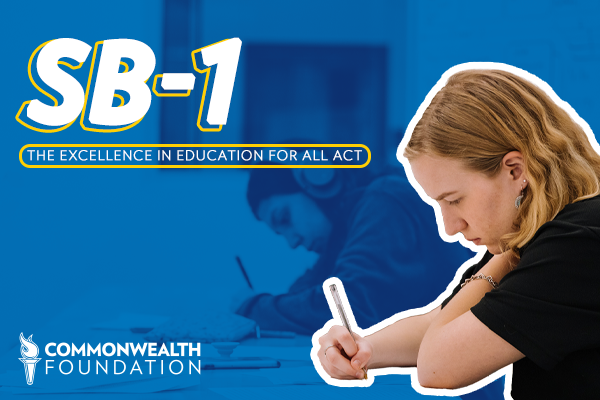Fact Sheet

Excellence in Education for All Act Summary
The Excellence in Education for All Act (Senate Bill 1) is an exciting bill that seeks to ensure more Pennsylvania children have access to an excellent education. It contains two main components:
- Increasing the Educational Improvement Tax Credit (EITC) and Opportunity Scholarship Tax Credit (OSTC) programs so students don’t miss out on great opportunities.
- Reforming Pennsylvania’s charter schools while preserving and enhancing choice for families.
Why do we need this legislation?
Children have struggled with a full year of disrupted learning due to the pandemic. Now, more than ever, parents need a broad range of education solutions to fill the gap.
- Pennsylvania’s tax credit scholarship programs increase educational opportunities by allowing businesses and community leaders to join together to support Pennsylvania schoolchildren. Unfortunately, the existing program caps are denying students opportunity. Last year alone, nearly 43,000 scholarship applications were denied because of the caps. At the same time, there is a waiting list of donors willing to give more than $121 million to eligible students under the EITC and OSTC programs.
Expanding the tax credit scholarship programs to reflect student need will ensure Pennsylvania students won’t be left on waitlists, desperate for better educational opportunities.
- Charter schools have proven to be the best educational option for hundreds of thousands of Pennsylvania students. There has been broad consensus for several years that some reforms are needed to the state’s charter school law in order to treat charter students more equitably and ensure the highest ethics among charter operators.
How does SB1 impact EITC and OSTC?
This legislation provides for the following increases beginning in FY 2021–2022:
- Increase the EITC program cap from $185 million to $300 million:
§ Credits for K-12 scholarships go from $135 million to $185 million.
§ Credits for Pre-K scholarships go from $12.5 million to $15 million.
§ Credits for Educational Improvement Organizations go from $37.5 million to $50 million.
§ Students in economically disadvantaged schools would have access to $50 million in additional scholarship funding.
- Increase the OSTC program from $55 million to $100 million.
- Each program would thereafter increase by 25% annually if 90% of the available tax credits are used in the previous year.
It’s important to realize that these amounts are a small fraction of the $32.7 billion spent on public schools last year.
What would be the financial impact of the EITC/OSTC portion of SB1?
The average tax credit scholarship is just $2,100, which is nearly 90% less than the $19,100 spent per student in Pennsylvania public schools. An 2020 analysis[i] by Dr. Martin Lueken of EdChoice concluded that a $100 million EITC increase would save state and local taxpayers a combined $265 million. The projected savings from SB1 are even greater.
From the district’s financial perspective, increasing tax credit scholarships is a massive boon since districts retain all local and almost all state funding for students who are no longer attending their schools.
How does SB1 impact charter schools?
Charter school reforms in the bill include stronger and clearer ethics requirements for charter school leaders; charter appeal board accountability; access for charter school students to school buildings and testing sites; and allowing charter school students the opportunity to participate in dual enrollment programs at institutions of higher education, just like their peers in district schools.
In response to pressure from teachers’ unions and school district associations, the bill also cuts funding for public cyber charter students—despite cyber students already receiving less funding than district students.
What would be the financial impact of the charter school portion of SB1?
School districts exist to facilitate the education of children—funded by taxpayers—at public schools. When children remain at the district school, the district pays the cost of educating them within the district. When children choose charter schools, the district pays the cost of educating them at charter schools.
- On average, Pa. charter schools receive less funding per student, as school districts keep around 25% of funding for students who attend charter schools—paying around $15,000 per child at charter schools, compared to $19,500 per child at district schools. Charter school funding is based on each district’s per-pupil costs after subtracting certain expenditures like transportation, facilities, and debt services.
- As of 2020, if charter schools received the same amount of funding per student as district schools, they would receive nearly $2.9 billion for the nearly 147,000 students enrolled.[ii] Instead, they received less than $2.5 billion. In other words, charter schools are saving school districts and taxpayers $400 million per year. Charter school expansion would likely result in additional savings as charters tend to operate on less funding than district schools.
- With the funding cut to cyber charter students, districts will retain up to an additional $1,500 for each student who attends a cyber charter school.
It’s worth noting that charter school funding increases as enrollment increases. If no students enroll in a charter school, the school will receive no funding. At district schools, there is no such link, as illustrated in the chart below.
[i] EdChoice Fiscal Impact Statement, Pennsylvania 2020 Budget Session, https://www.commonwealthfoundation.org/docLib/20200520_PAHB800FiscalNote_FY2021.pdf?t=5/20/2020%205:10:27%20PM.